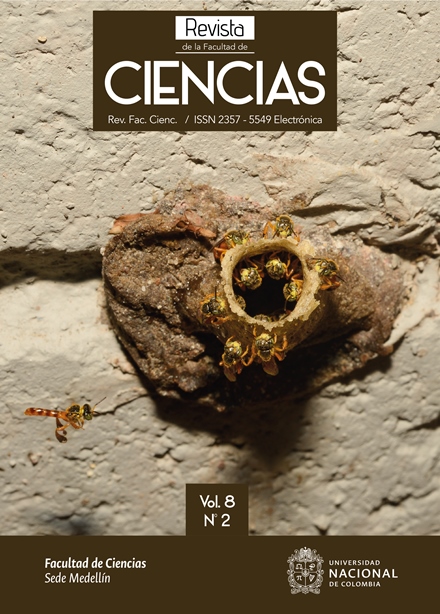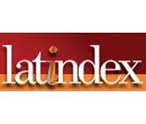Carta de control T de ARL insesgado con parámetro estimado
ARL unbiased control T chart with estimated parameter
DOI:
https://doi.org/10.15446/rev.fac.cienc.v8n2.69524Keywords:
ARL (longitud promedio de corrida), ARL insesgado, distribución exponencial, tiempo entre eventos (es)ARL (average run length), ARL unbiased, time between events, exponential distribution (en)
Downloads
Usualmente las cartas de control se construyen con estimaciones de los parámetros asociados a la distribucion de la variable o estadístico que se monitorea; sin embargo, se asume que estos son conocidos y en consecuencia, no se consideran los efectos que las estimaciones tienen sobre el desempeño de la carta.
En este trabajo se estudian los efectos de la estimación del parámetro de la carta t, la cual es usada para monitorear el tiempo entre eventos, asumiendo que esta variable sigue una distribucion exp(lambda_0). Para ello, se hizo un análisis inicial de la longitud promedio de corrida (ARL) cuando se usa un valor estimado para
este parámetro. El análisis preliminar permitió ver que la carta es de ARL sesgado; es decir, su ARL no es máxima cuando el proceso está en control. Además, se pudo mostrar que cuando lambda_0 es estimado, esta estimación afecta signicativamente la tasa de falsa alarma y la ARL cuando el tamaño de la muestra usada
para esta estimación es pequeña. En consecuencia, se estudian y proponen correcciones de los límites de control, con el fin de obtener una carta de ARL insesgado. Se consideró la construcción de límites de control con probabilidades de colas con valores nominales iguales y diferentes y se trabajó con dos criterios de optimización en cada caso, en el primero se hallaron correcciones tales que la carta fuera de ARL insesgado y su valor en control igual a una cantidad deseada; en el segundo criterio, además de buscar correcciones
para lograr una carta de ARL insesgado, se buscó alcanzar una tasa de falsa alarma deseada. Los resultados sugieren que cuando se corrigen los límites, es mejor fijar la ARL en lugar de la tasa de falsa alarma, sin embargo, es indiferente denir los límites con colas nominales de igual o distinta probabilidad, de la misma forma, resulta indiferente la elección de uno u otro estimador entre los dos que fueron considerados en este artículo.
The control charts are usually constructed with estimates of the parameters associated to the distribution of the variable or statistic being monitored; however, it is assumed that these parameters
are known, and therefore the efects that estimates have on the performance of the chart are disregarded. This paper studies the eects of the estimation of the parameter of the chart t, which is used to monitor the time between events, assuming that this variable follows a distribution exp(lambda_0). For this, an initial analysis of the average run length ARL for the chart was made when lambda_0 is an estimated value for this parameter. The preliminary analysis showed that the chart in either case is not of ARL unbiased, it means that its ARL is not maximized when the process is in control. In addition, it was shown that when lambda_0 is estimated, this estimation afects signicantly the false alarm rate and the ARL when the sample size used for this estimation is small. Consequently, corrections to the limits of control are studied and proposed in order to obtain a chart of ARL unbiased. The construction of limits were considered with probabilities of tails with equal and diferent nominal values, two optimization criteria were taken into consideration in each case, in the first criterion, corrections were found such that the chart be of ARL unbiased and also the ARL in control satisfying a desired value; in the second criterion, not only looked for corrections to achieve an unbiased
ARL but also sought to achieve a desired false alarm rate. The results suggest that when estimating the parameter and correcting the limits, it is better to set the ARL instead of the false alarm rate, however, it is irrelevant to dene the limits with probabilities of tails with equal nominal values or dierent, in the same way, the choice of one or another estimator among the two that were considered in this article is indiferent.
References
Aslam, M., Azam, M. & Jun, C.-H. (2015). A new control chart for exponential distributed life using ewma., Transactions of the Institute of Measurement and Control 37(2), 205–210. DOI: 10.1177/0142331214537293.
Borror, C. M., Keats, J. B. & Montgomery, D. C. (2003). Robustness of the time between events cusum, International Journal of Production Research 41(15), 3435–3444. DOI: 10.1080/0020754031000138321.
Calvin, T. W. (1983). Quality control techniques for zero-defects, IEEE Transactions on Components, Hybrids, and Manufacturing Technology 6(3), 323–328. DOI: 10.1109/TCHMT.1983.1136174.
Chakraborti, S. (2007),. Run length distribution and percentiles: The shewhart chart with unknown parameters., Quality Engineering, 19(2), 119 – 127. DOI: 10.1080/08982110701276653.
Chan, L. Y., Xie, M. & Goh, T. (2000). Cumulative quantity control charts for monitoring production processes, International Journal of Production Research 38(62) , 397–408. DOI: 10.1080/002075400189482.
Cheng, C.-S. & Chen, P.-W. (2010). An ARL-unbiased design of time-between-events control charts with runs rules, Journal of Statistical Computation and Simulation, 81(7), 857–871. DOI: 10.1080/00207543.2014.974848.
Goh, T. N. (1987). A control chart for very high yield processes, Quality Assurance, 13(1), 18–22.
Guo, B., Wang, B. X. & Xie, M. (2014). ARL-unbiased control charts for the monitoring of exponentially distributed characteristics based on type-II censored samples, Journal of Statistical Computation and Simulation, 84(12), 2734–2747. DOI: 10.1080/00949655.2014.898766.
Huang, S. & Yang, J. (2015). An ARL-unbiased design of gamma control chart, in ‘2015 First International Conference on Reliability Systems Engineering (ICRSE)’, pp. 1–6.
Jensen, W. A., Jones-Farmer, A., Charles, C. & Woodall, W. (2006). Effects of parameter estimation on control chart properties: A literature review, Journal of Quality Technology, 38(4), 349–364.
Khoo, M. B., Lee, M., Teoh, W., Liew, J. & Teh, S. (2013). The effects of parameter estimation on minimising the in-control average sample size for the double sampling X¯ chart, South African Journal of Industrial Engineering, 24(3), 58-67.
Kumar, N., Chakraborti, S. & Rakitzis, A. C. (2017). Improved shewhart-type charts for monitoring times between events, Journal of Quality Technology, 49(3), 278–296. DOI: 10.1080/00224065.2017.11917995.
Montgomery, C. D. (2007). Introduction to statistical quality control, John Wiley & Sons.
Ozsan, G., Testik, M. C. & Weiβ, C. H. (2010). Properties of the exponential EWMA chart with parameter estimation, Quality and Reliability Engineering International, 26(6), 555–569. DOI: 10.1002/qre.1079.
Psarakis, S., Vynioua, A. K. & Castagliola, P (2014). Some recent developments on the effects of parameter estimation on control charts, Quality and Reliability Engineering International, 30(8), 1113-1129. DOI: 10.1002/qre.1556.
Radaelli, G. (1998). Planning time-between-events Shewhart control charts, Total Quality Management 9(1), 133–140. DOI: 10.1080/0954412989324.
Ryan, T. (2011). Statistical Methods for Quality Improvement, John Wiley & Sons..
Saghir, A., Lin, Z. & Chen, C.-W. (2015). The properties of the geometric-poisson exponentially weighted moving control chart with estimated parameters, Cogent Mathematics, 2 (1), 992381. DOI: 10.1080/23311835.2014.992381.
Santiago, E. & Smith, J. (2013). Control charts based on the exponential distribution: Adapting runs rules for the t chart, Quality Engineering, 25(2), 85–96. DOI: 10.1080/08982112.2012.740646.
Soetaert, K. (2015), rootSolve: Nonlinear root finding, equilibrium and steady-state analysis of ordinary differential equations[Software]. R-package version 1.7.
Tang, L. C. & Cheong, W. T. (2004). Cumulative conformance count chart with sequentially updated parameters, IIE Transactions, 36(9), 841–853. DOI: 10.1080/07408170490473024.
Knoth, S., & Schmid, W. (Eds.). (2015). Frontiers in Statistical Quality Control 11, Springer International Publishing, chapter Some Recent Results on Monitoring the Rate of a Rare Event, pp. 15–27. DOI: 10.1007/978-3-319-12355-4.
Woodall, W. H. & Montgomery, D. C. (2014). Some current directions in the theory and application of statistical process monitoring, Journal of Quality Technology 46(1), 78–94.
Xie, M. & Goh, T. N. (1992). Some procedures for decision making in controlling high yield processes, Quality and Reliability Engineering International, 8(4), 355–360. DOI: 10.1002/qre.4680080409.
Xie, M., Goh, T. N. & Kuralmani, V. (2000). On optimal setting of control limits for geometric chart, International Journal of Reliability, Quality and Safety Engineering, 7(01), 17–25.
Xie, M., Goh, T. & Ranjan, P. (2002). Some effective control chart procedures for reliability monitoring., Reliability Engineering and System Safety, 77(2), 143-150.
Yang, Z., Xie, M., Kuralmani, V. & Tsui, K.-L. (2002). On the performance of geometric charts with estimated control limits, Journal of Quality Technology, 34(4), 448–458.
Yen, F. Y., Chong, K. M. B. & Ha, L. M. (2013). Synthetic-type control charts for time-between-events monitoring, PLoS one 8(6), 1–13. DOI: 10.1371/journal.pone.0065440.
Zhang, C. W., Xie, M. & Goh, T. N. (2005). Economic design of exponential charts for time between events monitoring, International Journal of Production Research, 43(23), 5019–5032. DOI: 10.1080/00207540500219387.
Zhang, C. W., Xie, M. & Goh, T. N. (2006). Design of exponential control charts using a sequential sampling scheme, IIE Transactions, 38(12), 1105–1116. DOI: 10.1080/07408170600728905.
Zhang, M., Peng, Y., Schuh, A., Megahed, F. M. & Woodall, W. H. (2013). Geometric charts with estimated control limits, Quality and Reliability Engineering International, 29(2), 209–223. DOI: 10.1002/qre.1304.
How to Cite
APA
ACM
ACS
ABNT
Chicago
Harvard
IEEE
MLA
Turabian
Vancouver
Download Citation
License
Copyright (c) 2019 Revista de la Facultad de Ciencias

This work is licensed under a Creative Commons Attribution-NonCommercial-NoDerivatives 4.0 International License.
The authors or copyright holders of each paper confer to the Journal of the Faculty of Sciences of Universidad Nacional de Colombia a non-exclusive, limited and free authorization on the paper that, once evaluated and approved, is sent for its subsequent publication in accordance with the following characteristics:
- The corrected version is sent according to the suggestions of the evaluators and it is clarified that the paper mentioned is an unpublished document on which the rights are authorized and full responsibility is assumed for the content of the work before both the Journal of the Faculty of Sciences, Universidad Nacional de Colombia and third parties.
- The authorization granted to the Journal will be in force from the date it is included in the respective volume and number of the Journal of the Faculty of Sciences in the Open Journal Systems and on the Journal’s home page (https://revistas.unal.edu.co/index.php/rfc/index), as well as in the different databases and data indexes in which the publication is indexed.
- The authors authorize the Journal of the Faculty of Sciences of Universidad Nacional de Colombia to publish the document in the format in which it is required (printed, digital, electronic or any other known or to be known) and authorize the Journal of the Faculty of Sciences to include the work in the indexes and search engines deemed necessary to promote its diffusion.
- The authors accept that the authorization is given free of charge, and therefore they waive any right to receive any emolument for the publication, distribution, public communication, and any other use made under the terms of this authorization.
- All the contents of the Journal of the Faculty of Sciences are published under the Creative Commons Attribution – Non-commercial – Without Derivative 4.0.License
MODEL LETTER OF PRESENTATION and TRANSFER OF COPYRIGHTS
Personal data processing policy
The names and email addresses entered in this Journal will be used exclusively for the purposes set out in it and will not be provided to third parties or used for other purposes.





















